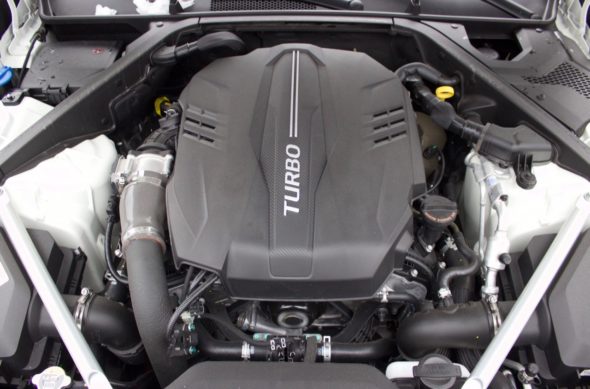
The Kia K900 debuted for the 2015 model year as a genuine competitor to established full-size luxury sedans like the BMW 7 Series, Audi A8, and Mercedes-Benz S-Class.
Or, at least, that was the plan.
Despite an impressive spec sheet, Kia’s big cruiser failed to gain real traction in the luxury segment. With a total redesign for 2019, Kia is giving the K900 another go. To start, the V8 has been replaced by a more modern twin-turbo V6. The infotainment system pairs a euro-style rotary controller with a touch-sensitive screen. And all-wheel drive now comes on every K900. This all qualifies as what the auto industry likes to call “a good start.”
To see if the new K900 is truly a luxury competitor, we slogged through nearly an hour of Boston traffic before enjoying nearly 200 uninterrupted miles of highway on our way to Burlington, Vermont. After all, what better way to gauge a full-size luxury sedan than a road trip?
This Sure Doesn’t Feel Like a Kia
The first thing you’ll notice when entering the K900 is how it doesn’t feel like a run-of-the-mill Kia. Brown Nappa leather covers nearly every inch of the cabin, and the 20-way adjustable driver seat means anyone behind the wheel will be able to find a comfortable position. The backseat, in particular, fills the primary requirement of a luxury sedan: Sitting in the second row will make you feel like the most important person in the car, not like you’ve been relegated there because the front seat was taken.

The K900 feels smaller than it is, too. Don’t be surprised if passengers suggest it’s a midsize sedan, rather than a full-size. With the help of Kia’s surround-view camera, it’s as easy to park and maneuver as a smaller car, too.
That said, the second thing you’re likely to notice is the K900’s rapidly dropping fuel-gauge needle. Driving through traffic, the K900 was quiet and powerful, although surprisingly different than a Kia Stinger or Genesis G70, both of which use the K900’s engine. Rather than sprinting from stoplights like those two sports-oriented machines, the K900 swept us away with very little drama. All of that sweeping, however, takes a toll on fuel economy. Even with two fewer cylinders than the previous-generation K900, don’t expect this one to be a gas sipper.

Granted, things got better once we hit the highway. Silence is possibly the K900’s most noteworthy attribute. Smooth power delivery and a peaceful ride are requirements of any luxury car, and the K900 offers both. Combined with adaptive cruise control and lane-keeping assist, I finished a 3.5-hour drive to Lake Champlain astonishingly refreshed. Something as abstract as “quiet” is tough to notice when driving, but once you do, you’ll continually appreciate it. By keeping me alert and refreshed, the lack of droning road noise is practically a safety feature.
Safety Comes Standard
On the topic of safety, cameras and sensors are almost compulsory in a sedan as big as the K900. Kia’s suite of advanced safety features does make driving much easier, and the unique blind-spot cameras are particularly helpful. When the driver hits a turn signal, the K900’s instrument panel will replace either the left or right gauge with a digital video feed from a camera mounted under the corresponding wing mirror. The picture is predictably grainy during night-time driving, but still provides a clearer view of the K900’s blind spots than its wing mirrors do.

A Good Value… Today
Unfortunately, the K900’s appointments, performance, and safety can’t help it clear its current hurdle. Nor can the car’s 12.3-inch touchscreen or 17-speaker Lexicon sound system, as impressive as they are. On the surface, the K900 appears to be a great deal. Its sub-$65,000 price certainly makes it a financially pragmatic approach to luxury; this car offers 90% of what you can get from a BMW 7 Series at 70% of the price.

But developing a car takes a long time—years, at least. So, when Kia was designing the K900 for a 2015 model-year launch, a big V8 engine and rear-wheel drive fit the bill. But Kia quickly found itself behind the times with that formula, as shoppers showed greater interest in fuel economy and all-wheel drive. The resale values of those early K900s support this; take a look around, and you’ll find plenty of low-mileage first-generation cars priced well below $30,000.
Similarly, the 2019 Kia K900 has been developed to suit those 2018 desires, but the world of luxury is now pivoting hard toward hybrid and all-electric powertrains. As a result, the Porsche Taycan and Tesla’s Model S, Model X, and Model 3 look like the future of luxury, and even the more conventional 7 Series now offers a hybrid variant. Today, the K900 looks and feels amazing. But I can’t help but wonder if, tomorrow, it will have aged the way many older full-size sedans have: classically cool at best, outmoded and inefficient at worst.
All photos by CarGurus contributor George Kennedy.
For more car news, check out these articles:
- The 2020 Toyota 4Runner Offers Old-School Cool with New-Age Tech
- How Many Turkeys Can Our Most-Watched Crossovers Hold?
- Ten Best Cars for Lovers of the Great Outdoors
The post The 2019 Kia K900 Excels as a Classic Luxury Flagship appeared first on The CarGurus Blog.
from The CarGurus Blog https://blog.cargurus.com/2019/11/29/the-2019-kia-k900-excels-as-a-classic-luxury-flagship
via Car Gurus
No comments:
Post a Comment